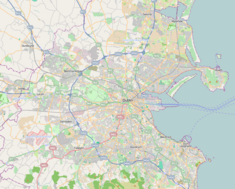
The Pale or the English Pale was the part of Ireland directly under the control of the English government in the Late Middle Ages. It had been reduced by the late 15th century to an area along the east coast stretching from Dalkey, south of Dublin, to the garrison town of Dundalk. The inland boundary went to Naas and Leixlip around the Earldom of Kildare, towards Trim and north towards Kells. In this district, many townlands have English or French names, the latter associated with Norman influence in England.

Dalkey is an affluent suburb of Dublin, and a seaside resort southeast of the city, and the town of Dún Laoghaire, in the county of Dún Laoghaire–Rathdown in the traditional County Dublin, Ireland. It was founded as a Viking settlement and became an active port during the Middle Ages. According to chronicler John Clyn (c.1286–c.1349), it was one of the ports through which the plague entered Ireland in the mid-14th century. In modern times, Dalkey has become a seaside suburb that attracts some tourist visitors.
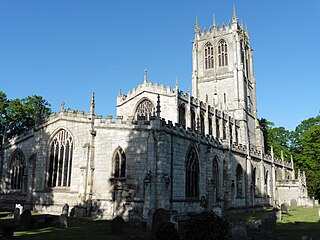
Tickhill is a market town and civil parish in the City of Doncaster, South Yorkshire, England, close to the border with Nottinghamshire. At the 2001 census it had a population of 5,301, reducing to 5,228 at the 2011 Census.

Carrickfergus Castle is a Norman castle in Northern Ireland, situated in the town of Carrickfergus in County Antrim, on the northern shore of Belfast Lough. Besieged in turn by the Scottish, native Irish, English, and French, the castle played an important military role until 1928 and remains one of the best preserved medieval structures in Northern Ireland. It was strategically useful, with 3/4 of the castle perimeter surrounded by water. Today it is maintained by the Department for Communities as a state care historic monument, at grid ref: J4143 8725.

Killiney is an affluent suburb in the southern coastal part of County Dublin, Ireland. It lies south of Dalkey, east and northeast of Ballybrack and Sallynoggin and north of Shankill. The place grew around the 11th century Killiney Church, and became a popular seaside resort in the 19th century. The area is notable for some famous residents, including two members of U2, and Enya.

Swansea Castle is located in the city centre of Swansea, Wales, UK. It was founded by Henry de Beaumont in 1107 as the caput of the lordship of Gower. The castle is now ruined and only two blocks remain, though the site has been improved in the 2010s for use as a public space.
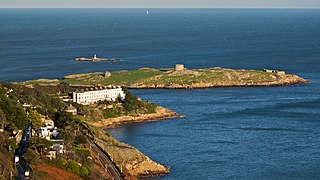
Dalkey Island is an island for which the nearby village of Dalkey is named. It is an uninhabited island located in the county of Dún Laoghaire-Rathdown, about 16 km (9.9 mi) south of Dublin and 3 km (1.9 mi) south of Dún Laoghaire harbour. An important site of pilgrimage for centuries, it has been known as "St Begnet's Isle" since records began. The earliest reference to 'Dalkey Island' is from c. 1782. The island had a population of 8 in 1841.

Cabrerets is a commune in the Lot department in southwestern France.

Henry Algernon Percy, 5th Earl of Northumberland, KG was an English nobleman and a member of the courts of both Kings Henry VII and Henry VIII.

Archbold Stadium was a multi-purpose stadium in Syracuse, New York. It opened in 1907 and was home to the Syracuse Orangemen football team prior to the opening of the Carrier Dome in 1980.
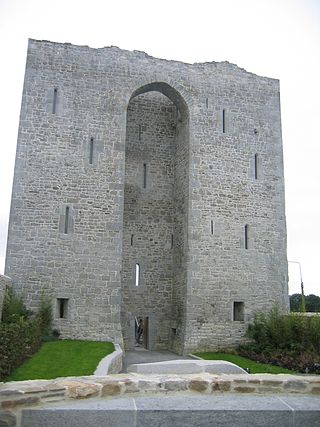
Listowel Castle, located near the town of Listowel, County Kerry in Ireland, was built in the 15th century. The castle is a noted example of Anglo-Norman architecture in County Kerry, and has been the subject of several restoration projects. It is now protected as a national monument, and is open to the public for tours on a daily basis.

Buittle is an ecclesiastical and civil parish in Dumfries and Galloway, southwest Scotland, in the traditional county of Kirkcudbrightshire. It lies to the west of the Urr Water, between Dalbeattie and Castle Douglas, and extends from Haugh of Urr in the north to Almorness Point on the Solway Firth in the south. The main settlement is the small village of Palnackie.

Glanworth is a village on the R512 regional road in County Cork, Ireland. It lies approximately 8 kilometres (5 mi) northwest of the town of Fermoy and 40 km (25 mi) northeast of Cork city. As of 2016, Glanworth's population was 603.
Castle Camps was a Norman Castle located in what is now the civil parish of Castle Camps, Cambridgeshire.

Bullock Harbour or Bulloch Harbour is a small working harbour located near the heritage town of Dalkey on the southeast coast of Dublin Bay in Ireland.

Killiney Hill is the southernmost of the two hills which form the southern boundary of Dublin Bay, the other being Dalkey Hill. These two hills form part of Killiney Hill Park.

Cloughoughter Castle is a ruined circular castle on a small island in Lough Oughter, 4 kilometres (2.5 mi) east of the town of Killeshandra in County Cavan, Ireland.
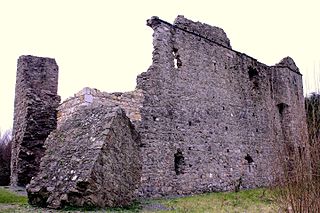
Kindlestown Castle is a castle and a National Monument in Delgany, Ireland.

Dalkey Castle, formerly known as Goat Castle, is a medieval structure in Castle Street, Dalkey, Dublin, Ireland. The complex currently accommodates the Dalkey Heritage Centre, in the castle itself, and Dalkey Town Hall, which is formed by a single storey extension behind the original building.

